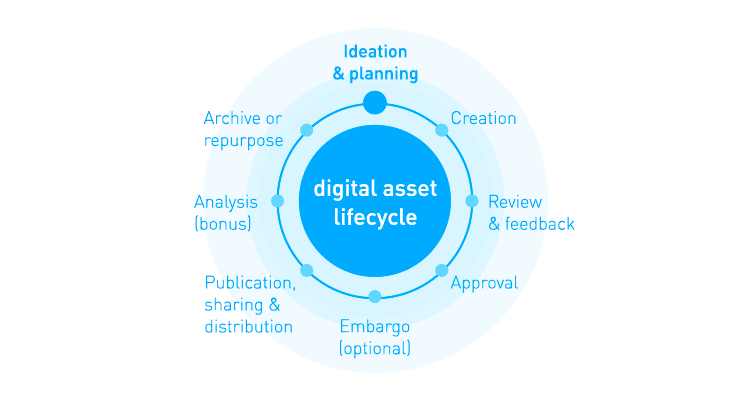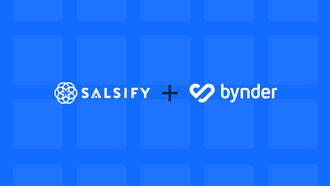Today’s digital asset management solutions have evolved to do so much more than simply storing digital assets. From accelerating content production and improving brand consistency, to integrating with today’s most widely-used marketing technologies, digital asset management is at the heart of a well-operating modern marketing digital ecosystem.
And more and more businesses are adopting DAM, with the industry expected to be valued at $8 billion by 2027, growing 13% year-on-year according to MarketsandMarkets.
If you’re yet to implement a digital asset management solution, you may be curious about the best way to not only store digital assets with DAM, but also uncover the benefits from its ever-evolving range of features and functionalities. Check out our overview below to help you on your DAM journey.
What are digital assets?
Put simply, a digital asset is any piece of content that is stored digitally. However, the term is often used by modern organizations to specifically describe digital files that have real value – such as original branding, marketing, or product collateral.
A digital asset is a digital file that an organization has invested time and resources into creating that has current or enduring business value to an organization.
Because of the investment in this content, organizations need to ensure they have highly secure digital asset storage that protects their intellectual property, while at the same time making assets organized and accessible to the right people at the right time. When digital assets are properly stored, it empowers teams to distribute tailored content to a variety of channels to reach new audiences.
What are some digital asset examples?
Examples of digital assets include well-known file formats such as documents, images, and videos, but businesses also use DAM to store digital assets such as brand design files (logos, icons, templates), brand guidelines assets, PDFs, audio recordings, confidential/legal documents, and much more.
Why do businesses use DAM for digital asset storage?
Valuable time and resources go into creating digital assets, so it’s crucial that they’re kept safely secured, and organized in a way that makes it quick and easy to find files as and when it’s needed. As mentioned before, digital asset management tools offer many more benefits than your typical file-storage solution such as DropBox or WeTransfer – DAM enables organizations to manage and drive efficiencies across the entire content lifecycle.

Here are a few bottom-line benefits of storing digital assets with DAM, as told by 500 of Bynder’s digital asset management customers in the DAM ROI report:
80% increased reuse of existing assets
86% reported improved collaboration in their marketing organization
85% made their digital asset permissions and copyrights more secure
The ROI of Bynder is seen in the time it saves us, the increased number of assets in circulation, and the improved productivity of our design operations.Michael Robinson
Creative Director at Nautilus
What's the benefit of using DAM over cloud storage systems?
While both are used for storing digital assets, DAM solutions offer so much more than just digital asset storage, file-sharing, or file-hosting – it enables organizations to create, manage and distribute exceptional content experiences across the entire content lifecycle.
With a strategic digital asset management solution, organizations can “do more with less” by having a collaborative, self-service single source of truth for storing and managing their entire digital asset library. This improves asset reusage, reduces the likelihood of duplicates, and having a tailor-made file taxonomy ensures a more intuitive organization of assets that doesn’t require endless folder searching.
From a branding perspective, digital asset management tools help maintain brand integrity and consistency by acting as a central repository for brand guidelines. Organizations can ensure only the latest, brand-approved versions of all logos and marketing materials are available to partners, teams, and agencies.
Perhaps the most essential function of a DAM is to ensure highly secure digital asset storage. Sharing highlay confidential digital assets via email or unreliable file-transfer services can inevitably have serious repercussions for a business. By storing digital assets in a DAM, digital rights management, usage permissions for key assets, and file-sharing protocols typically adhere to strict standards that guarantee strict security. See Bynder’s digital asset management security certifications here.
What's the difference between DAM and file storage?
DAM lets you restrict or enable access to your digital library based on user roles, and enables you to share knowledge and content more broadly across your company in the same way an intranet might - the main difference being that DAM is content-focused.
DAMs aren’t just Dropbox alternatives; they are a lot more user-friendly too because they are essentially a digital brand library for all your digital marketing and branding assets. Think about a traditional, physical library and the way it’s organized to provide an optimal user experience. Digital asset management is more like a library, and simple cloud storage is more like the junk drawer in your kitchen.
How to store digital assets with DAM
Once you understand the needs of your organization and find the right DAM partner (maybe using our free DAM RFP template), it’s time to find the right system for your requirements. The best systems offer flexibility, a collaborative environment, a secure distribution system, and system adaptability for all stakeholders.
It’s crucial to get every element of digital asset management right, from the metadata structure to user adoption and even usage. The following steps should help you start the migration process on the right track:
Choose the right digital assets to migrate from your existing file-storage solution by using the digital asset appraisal checklist
Make DAM metadata and taxonomy a priority
Set reasonable expectations for the DAM migration process
Step 1: Choose the right digital assets to migrate off your existing solution
You should choose the right digital assets to migrate off your current file-storage solution, whether that’s Box, Dropbox, physical hard drives, or an internal server. Make sure you single out your most business-critical assets and transfer them first to the DAM to keep your business running without any hiccups. Next, look for assets that you may require in a few weeks, these go next. Lastly, transfer any archival materials, usually inactive files and folders that you are keeping just in case.
Helpful tip: Don’t forget raw files, as you’ll need these to refresh and update content in the future!
Step 2: Make DAM metadata and taxonomy a priority
Metadata and taxonomy are the powerhouses of search when it comes to digital asset management. Dedicate an appropriate amount of time to metadata and taxonomy for DAM. Chances are if you’ve been using Dropbox or Box, you are probably using a folder structure to organize your assets. Consider your folder structure and think about which parts might be helpful to re-purpose in your taxonomy (Examples: Year, photographer name, project type, content type, campaign name and more).
Taxonomy vs. metadata
Taxonomy is the structure to organize your DAM system and metadata is the data you use to describe your assets.
Taxonomy and metadata exercises can help you understand and create a metadata and taxonomy plan that makes your assets easier to find. Well-structured metadata makes the DAM platform more flexible and innovative, while also helping classify your assets in a better way. The best part about using metadata is that you don’t solely rely on folder and file names to refind files in the future. Dropbox, Google Drive, and other online file-sharing platforms don’t emphasize metadata and taxonomy in their product functionality to the extent that digital asset management platforms do, and that impacts the quality of search results, which are only as good as the metadata that assets are tagged with.
Here are a few important content pieces you might find helpful on taxonomy vs. metadata for DAM:
- The guide to building a digital asset library taxonomy
- Create a taxonomy for digital asset management in 5 easy steps
- Utilizing DAM terminology
Step 3: Set reasonable expectations for the migration process
How does the migration from cloud storage online to a DAM platform actually go?
Your chosen DAM solution provider may have a unique approach to data migration. So once you have sorted the assets and identified your metadata, talk to experts about further preparing and migrating your digital assets. There are many strategies and tactics for getting this done efficiently, but be prepared, migration is a big undertaking. That’s why Bynder devotes a lot of time to help advise and help construct a metadata and taxonomy plan that will set your team up for success – including ongoing customer support on every step of your DAM journey. You can read more about it in our “Mitigating DAM Implementation Risks Guide.”
Finally, remember that you’re setting your brand up with a solid foundation for the future
Getting a new marketing technology can be exciting, but the pain of migration is real. It takes time, resources, and forethought to make sure a digital asset migration is executed seamlessly.
Organizations that leverage the right DAM solutions for their data asset security and file-sharing needs also get to enjoy more streamlined workflows, better brand compliance, and more traction from their content. Siemens Healthineers's DAM use case is an excellent example of how to successfully migrate off traditional cloud storage and launch a DAM platform.
The usability of Bynder was the key USP for us; everything is so easy to use and the transparency it enables across the organization provides real peace of mind.Andre Koegler
Head of Digital Strategy & Tools, Creative Services at Siemens Healthineers
Results-driven and outcome-oriented digital asset management
DAM is critical if your goals are to get maximum ROI out of your brand’s content (think enabling sales teams to hit revenue targets, automating content on your website to create better content experiences, or driving internal operational efficiencies to get content to market faster.)
It is now more important than ever for businesses to develop a clear, concise, and consistent digital asset management strategy that can help them take advantage of its powerful capabilities, but more importantly, for brands to tie their DAM strategy to a key result or desired outcome.
Before you migrate to a new DAM, it’s important to spend some time thinking about the outcomes you want to achieve beyond just migration and adoption.
Outgrowing your current digital asset storage solution and need something more flexible and scalable?
👉See how DraftKings bet on Bynder to boost brand consistency and scale content experiences as they expand rapidly
Need to improve internal usage and communication of digital assets?
👉See how Queensland Health boosted asset reusage by 75% and improved content distribution in the wake of COVID-19Want to boost sales with always-ready, always-on product imagery?
👉See how Scotch & Soda run high-volume e‑commerce with DAM by Bynder.
Eager to fuel downstream martech systems with the right content at the right time?
👉See how Riwal used Bynder to push content to their customer app and to their website.
Ready to increase brand awareness and brand consistency across global markets?
👉See how Nordea drives brand awareness and consistency with Bynder.
Bynder is directly supporting our business objectives, and finding a solution that has this direct link is not easy when you're such a big company.Rikke Mai Kristensen
Senior Marketing Partner at Nordea
Starting with a compelling or critical objective for your business is key to proving ROI and getting the most out of your Bynder platform.
























